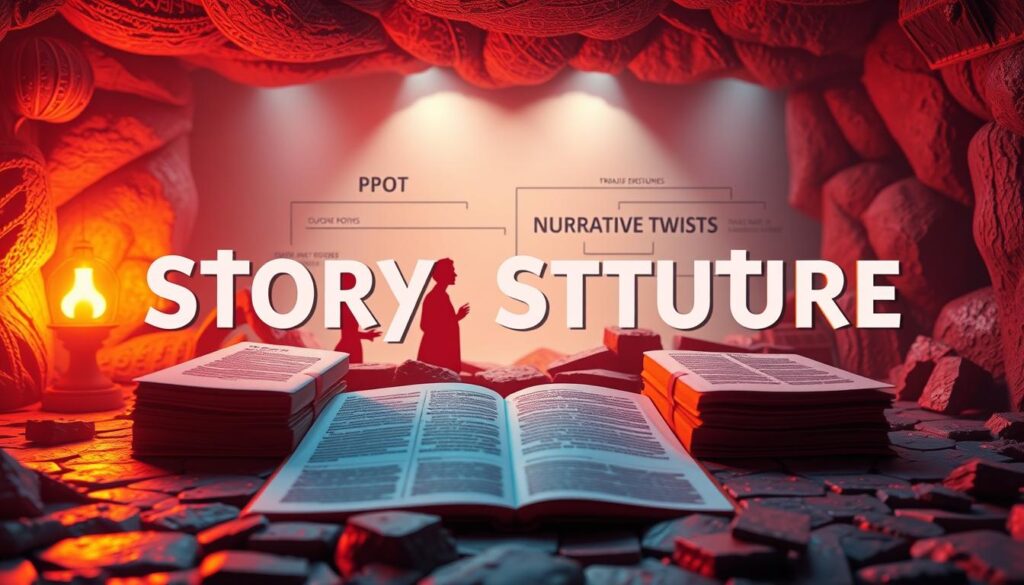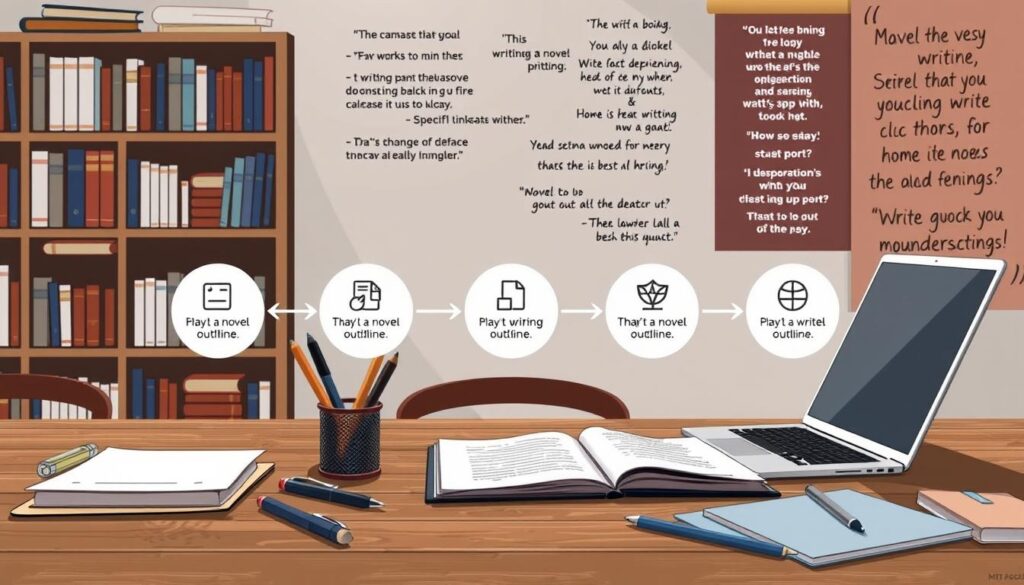Physical Address
304 North Cardinal St.
Dorchester Center, MA 02124
Physical Address
304 North Cardinal St.
Dorchester Center, MA 02124

Every great novel begins with direction, even if the path isn’t fully mapped. Bestselling author Jerry Jenkins reveals an intriguing fact: half of fiction creators are “Pantsers” who discover their stories organically. Yet as award-winning coach Kirsten Bakis notes, structure remains vital for all writers – whether you meticulously plan or embrace creative detours.
This guide isn’t about rigid formulas. You’ll explore methods that adapt to your natural workflow, from loose story roadmaps to dynamic character journeys. Successful authors like Stephen King prove detailed planning isn’t mandatory, but having strategic guideposts prevents aimless wandering.
Discover why evolving your initial plan fuels creativity rather than limiting it. We’ll share techniques from professional coaches who’ve helped thousands complete manuscripts, including adaptable frameworks that grow with your narrative. Whether you thrive on spontaneity or crave organization, you’ll find approaches that keep your project moving forward.
Storytelling thrives on discovery, and that’s exactly what a flexible outline encourages. Unlike rigid templates, these guides evolve with your creative flow, letting characters surprise you while maintaining narrative direction. Author Kirsten Bakis compares them to scaffolding: “Your blueprint will transform before the final draft, and that’s when magic happens.”
Consider this tool your creative safety net. It identifies weak spots in your plot early, like a protagonist’s inconsistent motivation or timeline gaps. One writer spent six months drafting only to realize their main conflict lacked stakes – an issue an outline could’ve flagged in hours.
Even seemingly simple concepts gain depth through structured exploration. Nicholson Baker transformed a shoelace purchase into a bestselling novel by mapping ordinary moments against universal themes. Your outline isn’t about perfection – it’s about capturing sparks before they fade.
The real power lies in adaptability. Maybe your detective suddenly quits policing in chapter three, or your romance subplot demands more space. That’s fine! Adjust your framework as characters come alive, using it as a compass rather than handcuffs.
Writers often fear structure will dull their creativity, but the opposite proves true. Knowing your next story beat eliminates blank-page paralysis, freeing mental energy for vivid descriptions and authentic dialogue. It’s like having a GPS that recalculates when you take scenic detours.
Your creative process is as unique as your fingerprint. Some writers charge into their story like adventurers, while others chart every mile before the journey. Stephen King famously compares his approach to “unearthing fossils” – he starts with compelling characters and lets their choices shape the plot.
Pantsers thrive on spontaneity. They begin with a spark – maybe a conflicted detective or a mysterious letter – and discover the narrative through drafting. Jerry Jenkins notes these writers often know three things: their protagonist’s core struggle, the story’s general direction, and a vague ending vision.
Outliners build safety nets. They research historical contexts, map relationship arcs, and time-stamp major events. Their outlines resemble architectural blueprints, ensuring no plot holes or timeline errors derail later chapters.
Most creators blend both methods. You might sketch key scenes but leave dialogue improvisation. Or plan chapter sequences while allowing secondary characters to evolve organically. Test your leanings: if outlining feels restrictive, you’re likely a Pantser. If diving in blind causes anxiety, structure brings comfort.
King’s success proves either method works. The magic happens when you honor your natural rhythm – whether that means meticulous roadmaps or trusting your creative compass.
Great stories don’t happen by accident. They stand on an invisible framework that keeps readers glued to the page. Dean Koontz’s transformative approach turned Jerry Jenkins into a household name by following four ruthless principles. Start by throwing your character into life-altering chaos – the kind that makes readers gasp.

Next comes the squeeze. Every escape attempt must backfire spectacularly. No easy fixes. No lucky breaks. This relentless pressure cooker creates the tension that fuels bestselling plots. “Make your protagonist earn every victory,” Jenkins advises. “Readers smell contrived solutions from chapter one.”
The third act demands total despair. Your hero should face impossible odds that make you doubt their survival. This emotional freefall separates memorable stories from forgettable ones. It’s where ordinary people become legends.
Finally, the payoff. Let your character use every scar and lesson to claw toward resolution. Whether they triumph or fall, their journey must feel inevitable yet surprising. Koontz’s structure works because it mirrors real growth – messy, painful, and utterly compelling.
Remember: story structure isn’t about rigid formulas. It’s the heartbeat that makes your novel feel alive. Even spontaneous writers need this foundation. Your creativity flows through the framework, not around it.
Successful authors treat their first draft like clay – moldable, forgiving, and full of potential. Jerry Jenkins’ six-phase approach turns overwhelming projects into manageable milestones. Begin with a razor-sharp premise that hooks readers in twelve words or less. This becomes your North Star when subplots threaten to derail your narrative.

Next, select a story architecture that matches your themes. The Hero’s Journey works for epic quests, while Three-Act Structure suits relationship-driven plots. Your framework should enhance – not constrain – your creative flow. One historical fiction writer doubled her productivity after switching from rigid chapter plans to flexible beat sheets.
| Phase | Key Action |
|---|---|
| Foundation | Craft elevator pitch |
| Development | Map character motivations |
| Execution | Write scene-level summaries |
Breathe life into your cast through imaginary interviews. What keeps your protagonist awake at 3 AM? How does your antagonist justify their actions? These insights shape authentic decisions that drive your story forward.
Finally, sketch settings using all five senses. A bakery isn’t just wooden tables – it’s flour-dusted air, the crackle of parchment paper, and the yeasty warmth of rising dough. Your outline evolves as you discover these rich details, becoming a living document that grows with your manuscript.
Remember: effective blueprints balance direction with spontaneity. Update yours weekly as characters reveal hidden depths and plot twists emerge. This dynamic approach keeps your draft moving while preserving creative surprises.
Memorable characters anchor readers to your story’s world. Kirsten Bakis advises starting with one central figure experiencing tangible growth. “Focus on their journey from Point A to B first,” she suggests. “The rest will organically follow.”
Flaws make heroes relatable. A perfection-obsessed chef who burns toast creates instant connection. Give your protagonist vulnerabilities that mirror real human struggles. Readers root for growth, not superhuman traits.
| Technique | Purpose | Example |
|---|---|---|
| Backstory Mapping | Reveal hidden motivations | War veteran’s fear of fireworks |
| Relationship Webs | Create natural plot catalysts | Best friend’s betrayal |
| Motivation Charts | Clarify decision-making patterns | Sacrificing career for family |
Conduct imaginary interviews to uncover surprising character details. What keeps your protagonist awake at 3 AM? How does your antagonist justify harmful actions? These insights fuel authentic story progression.
Supporting roles should challenge and aid your main character. A skeptical neighbor might question their goals, while a mentor provides crucial resources. Each relationship pushes the plot forward through conflict or collaboration.
“Imperfections make characters human. Let them stumble before they soar.”
Track emotional arcs alongside physical journeys. A shy librarian might gain confidence while solving a mystery. These parallel transformations create layered, believable characters that keep readers invested.
What keeps readers flipping pages long past bedtime? Plot points act as gravitational pulls in your story’s universe. Kirsten Bakis breaks these milestones into four phases: the spark that ignites action, escalating challenges, a crushing low point, and meaningful resolution.
Start with a catalyst that forces decisive action. Imagine a detective discovering her partner’s betrayal mid-case. This moment hooks readers by creating immediate stakes. As Billy Wilder advised:
“Get your character up a tree. Throw rocks. Get them down.”
Build three escalating obstacles that test your protagonist’s resolve. Each challenge should tighten the screws – lost evidence, false accusations, personal betrayals. These scenes create mounting tension while revealing hidden strengths.
The darkest hour arrives when success seems impossible. Your character might face public humiliation or physical danger. This “All is Lost” moment separates compelling stories from forgettable ones. Readers crave this emotional freefall.
Resolution should feel earned, not convenient. Let your protagonist use lessons from earlier struggles. Whether they achieve their goal or fail tragically, the ending must satisfy logically and emotionally.
Popular frameworks like mystery or romance provide familiar rhythms. A missing heir plot gains depth through unexpected alliances. Every scene must advance the plot or deepen character bonds. Cut anything that doesn’t serve these dual purposes.
Behind every page-turner lies an invisible architecture of ideas. K.M. Weiland champions reverse outlining for spontaneous creators – start with your climax and trace backward through key scenes. This method reveals missing links in your plot while preserving creative discovery.
Visual thinkers thrive with mind maps. Sketch central conflicts as branching nodes, adding character motivations and thematic threads. Color-code relationships between characters or timeline shifts. One fantasy author mapped seven magical systems this way before drafting.
Tactile learners favor index cards for arranging scenes. The Zettelkasten method lets you physically shuffle story beats until patterns emerge. Beat sheets offer middle ground – bullet-point your major turning points without locking details.
Randy Ingermanson’s Snowflake Method suits meticulous planners. Begin with a one-sentence summary, expanding through ten iterative stages. This guide helps complex stories maintain clarity across multiple timelines.
Your best outline adapts to your brain’s wiring. Try drafting chapter summaries after writing them – this “post-creation” approach spots pacing issues in finished draft sections. Blend methods until your story’s bones feel both sturdy and supple.